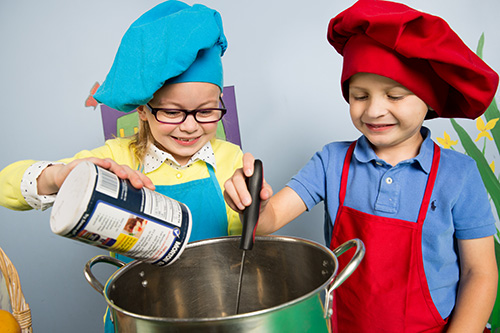Blog Posts | April 23, 2020
Share ThisHow Children's Museums are Fostering Imagination, Learning, and Creativity at Home

Physical museum buildings may be temporarily closed, but that doesn’t mean that learning, imagination, and discovery are on hold.
The Children's Museum of Manhattan (CMOM), for example, recognizes that healthy habits begin at home and that families play a crucial role in forming children’s healthy habits. The museum also understands that getting kids to eat nutritious food and get enough sleep and exercise are some of the struggles facing parents.
That’s why in 2009, with assistance from a National Leadership Grant from IMLS, the EatPlayGrow™ curriculum was designed to help children ages 2 to 5 years old living in New York’s low-income communities learn about nutrition and physical activity. Focus on this age group grew out of the CMOM and National Institutes of Health’s (NIH) We Can! (Ways to Enhance Children’s Activity & Nutrition)® program’s recognition of the importance of early childhood health education.
During this unprecedented time, while the museum is closed and families are spending more time at home together, CMOM is expanding their action-packed EatPlayGrow™ curriculum to provide daily free online resources and activities that families can do together.
The lesson plans in the program include fun art projects, games, songs, and physical activities that teach kids and their parents how to eat healthy and stay active. Families can find the materials online as part of the museum’s new CMOM at Home initiative or via daily emails. All activities and information are based on the latest medical and behavioral research and are linked to most important elements of a child’s day.
By working, eating, and actively playing side by side, families can model, replicate, and extend the health activities found in the EatPlayGrow™ curriculum. Kids and caregivers can play dance charades with CMOM partner Elisa Monte Dance Company, discover the magic of lava lamps with materials from around the house, bake traditional Irish soda bread and see a fizzy chemical reaction, and so much more.
When the social distancing restrictions associated with the COVID-19 pandemic subside, CMOM plans to bring EatPlayGrow™ installations and resources to families living in eight homeless shelters across Harlem, Brooklyn, and the Bronx with funding from a 2019 Museums for America grant. These installations will help establish health and learning hubs for children ages 0 to 3 in these shelters and communities.
Another of the many institutions providing exciting educational offerings to help keep kids busy during this time of social distancing is the DISCOVERY Children’s Museum in Las Vegas—and you don’t have to live in Nevada to “visit” DISCOVERY.
Knowing that families are looking for fun and educational activities to do at home with their children, the museum team developed a new online program, At Home DISCOVERIES.
The program features a carefully curated list of resources—both original and outside content—meant to help parents find ways to keep their kids learning. Resources include science demonstrations, story time, and DIY activity sheets that often include items parents and families already have at home. The museum team is continuing to add and update resources daily and ensure that there is a multitude of activities and videos, including art projects, DIY science experiments, tutorials, and more.
At the end of March, their Storytime series featured Nate Schmidt reading Curious George to kids. Schmidt, a defenseman for the National Hockey League’s Vegas Golden Knights, was the first special guest in a lineup the museum is planning for their channel this month.
Additional outside activities include Mo Willems’ Daily Doodles for all the art lovers out there, weekly science demonstrations by Science Mom, CBS News’ Steve Hartman’s ”Kindness 101,” Facebook Live series, ASL resources for kids, and resources in Spanish.
In just one month, these institutions have developed incredible ways to stay connected to their members, visitors, and children across the community—just two examples of museums across the country that are opening their virtual doors to all, demonstrating creativity, generosity, and resilience in the face of uncertainty.
Got something else to share? Drop us a line with other creative museum resources at imlsnews@imls.gov.
Photo courtesy of the Lynn Meadows Discovery Center.
